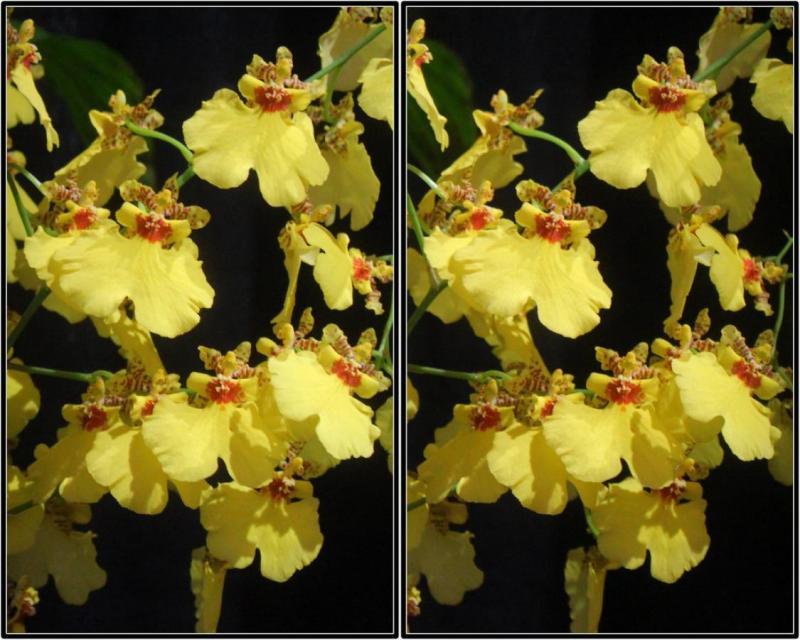Oncidium reflexum
Also known as: The Back or Oncidium funereum Oncidium suttonii Oncidium suave Oncidium acrochordonia Oncidium durangense Oncidium liebmannii Oncidium pelicanum Oncidium reflexum var. intermedium Oncidium wendlandianum Oncidium tayleurii Oncidium uncia Oncidium macropterum in the subfamily: Epidendroideae
Native to: El Salvador Guatemala Guerrero - Mexico Jalisco - Mexico Morelos - Mexico Oaxaca - Mexico
General Information
The Back is a medium sized sympodial cool to warm growing epiphytic orchid belonging to the sub family Epidendroideae native to El Salvador, Guatemala and Mexico.
Plant Description
Sympodial. Grows to 19-40cm. Each new growth has numerous leathery erect, lance shaped leaves that grow to 1.5-35cm long. Pseudobulbs grow to 2-6cm
Flowers
Numerous blossoms appear during Autumn
Blooming Season
- Autumn
Substrate(s)
- Coarse
- Medium
- Bark
- Charcoal
- Spaghnum Moss
- Perlite
Care Notes
This orchid goes into a dormancy phase during winter, during this phase it is best not to provide water unless the plant is starting to look thirsty. The lack of water increases the chance of flowering in spring, and also reduces the likelihood of any rot forming. Do not resume watering until new growth has appeared and is growing strongly.
Often a period of intense growth occurs after dormancy. During this time the amount of light, water and fertiliser the plant receives will directly impact the amount of growth that occurs during this time, and in the case of seedlings, will reduce the time required to reach maturity.
It's recommended to heavily reduce the water amount at the middle to end of autumn to trigger dormancy. Leaves on older bulbs will begin to drop during this time while the newer bulbs continue to mature until terminal leaves appear at the tip of the pseudobulbs.
Repotting can be done any time of the year though it's best to do it in early spring when new growth is appearing as this also means new roots will appear to help the plant anchor into the new media and offset any damage to established roots during the repotting process.
Climate
These orchids thrive in hot, steamy locations, living in low altitude jungle areas where they often receive heavy sporadic rainfall, warm humid winds, and sunlight filtered year round by the surrounding growth.
They can survive, but will often struggle if the humid, warm conditions are not met - roots will die back and leaves will thin out, spikes and buds can be aborted if conditions change too frequently during flowering. They can tolerate cooler or drier conditions temporarily, but extended exposure will seriously affect them.
They will grow best in the tropics, especially coastal areas where they receive ocean breezes, but can do well in a greenhouse, supplied that the humidity is kept high, temperature is not allowed to skyrocket and extra shade is provided during hot weather.
Grows at high elevations. Rainfall ranges from 3mm to 170mm per day, heaviest in June and lightest in January. Humidity ranges from 55% to 75%, highest in September and lowest in March. Temperature ranges from 8C to 31C, highest in April (16C to 31C) and lowest in January (8C to 25C).
Fertiliser
dormant-medium-demand-orchid Use balanced fertiliser during Spring and Summer. Apply fertiliser regularly at half strength year round. Use a high Nitrogen fertiliser during Spring and Summer. Use a high Phosphorous fertiliser during Summer.
Potting
These plants are quite forgiving and will do well repotted ever 2-3 years. The mix should be coarse, well draining, and allow space for air to move and for roots to grow.
Alternatively, these plants will also do well mounted to tree fern or cork slabs, or mounted to trees.
Best time for repotting or mounting the orchids is the end of winter when new growths start to appear. Avoid repotting during hot weather,
Use water retentive media such as moss to prevent roots from drying out quickly This plant does very well in baskets or suspended pots This plant does well mounted. Repotting is best done annually.


